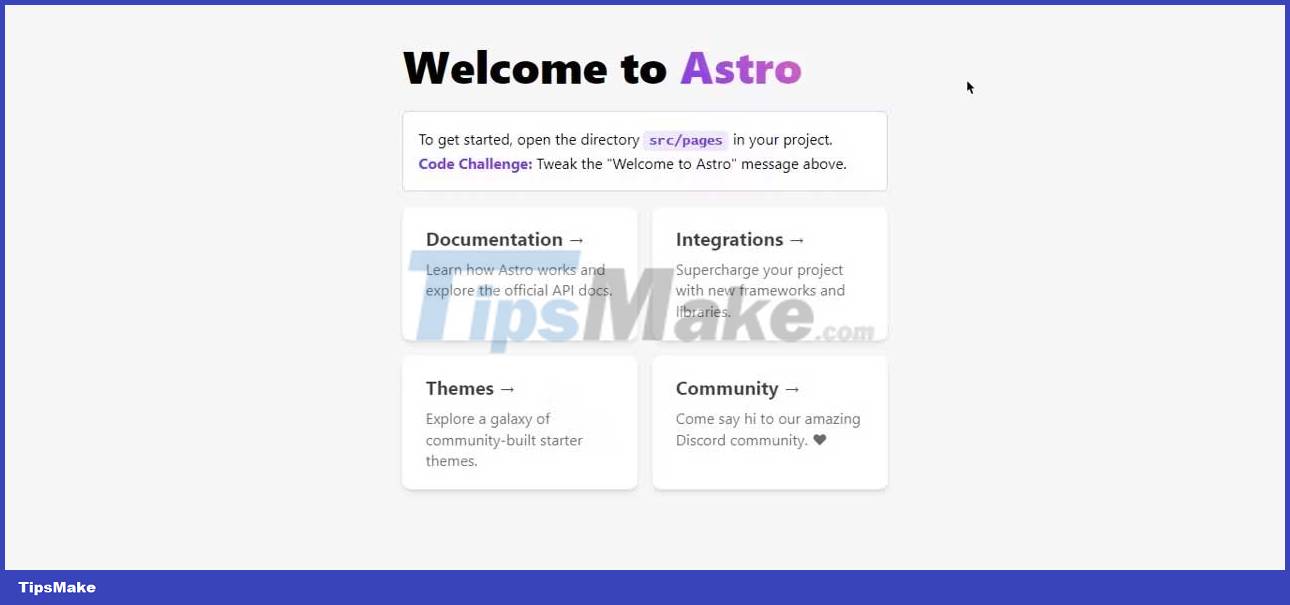New features worth trying in Astro 2.5

AstroJS is a great tool based on JavaScript, used to create static web pages super fast. It allows you to create websites using many JavaScript frameworks like React, Vue, and Svelte. Astro 2.5 brings a number of completely new features, specifically:
Data collection
Astro 2.5 now supports saving JSON and YAML in collections. New style: the 'data' attribute enables this. To illustrate that, let's create a 'writers' data collection in the src/content directory, where a JSON or YAML file can be added.
Next, configure the collection in src/content/config.ts using the defineCollection and z utilities from the astro:content module and set this data type.
import { z, defineCollection } from "astro:content"; const writers = defineCollection({ type: "data", schema: z.object({ name: z.string() }), });Finally, export the collection object to subscribe to the collection.
export const collections = {writers:writers}HTML Shrink

Astro 2.5 introduces the compressHTML option, which removes all whitespace (and line breaks) in HTML. Components are compressed only once by the Astro compiler and then during the build process. This is done to reduce performance costs.
Enabling the above selection in the project is easy. Just add the following lines to your config. HTML Minification only works with elements written in the .astro.
export default defineConfig({compressHTML:true})Parallelized Rendering
Parallel rendering of components is a long-awaited feature in Astro. In the case of sub-tree sub-components fetching data, Astro 2.5 improves load times by fetching data in parallel.
This allows a component deep in the tree to be displayed without being locked by a fetch element higher up in the tree. Currently, parallel rendering doesn't work with array.map asynchronous arrays .
Astro 2.5 also brings a bunch of other cool experimental features.
Hybrid Rendering
Astro 2.5 now allows you to define a new server output option in the config file, overriding SSR's default pre-rendered behavior.
To take advantage of hybrid rendering , set hybridOutput to true in the experimental section of the config and add the adapter.
Doing this defaults to pre-rendering the entire page, but you can choose that behavior by setting the output prerender of any route or page to false :
export const prerender = false;Custom Client Directives
Astro 2.5 introduces the addClientDirective API to control client-side component hydrates with custom client:* commands.
To use this feature, enable experimental.customClientDirectives in the config file and keep the directive entry points to a minimum to avoid any negative reactions to the component hydrates.
A ClientDirective import function will be exported from your client directive file. For example, the following code hydrates the ingredients on the first click of the window.
import { ClientDirective } from "astro"; const clickDirective: ClientDirective = (load, opts, el) => { window.addEventListener( "click", async () => { const hydrate = await load(); await hydrate(); }, { once: true } ); }; export default clickDirective;Client:click can now be used in components with full input support.
How to install Astro
Astro provides a Command Line Interface (CLI), named create astro to get you started. You need to install NodeJS 16+ and npm on your machine.
npm create astro@latestThis will create a new Astro project from the start. Follow the on-screen instructions to set everything up. Next, add cd to the project directory, and then run:
npm run devYou can add frameworks like React, with astro add . If everything is installed live, you can open localhost:3000 on your machine, and you will see the message "Welcome to Astro".

If you don't like NPM, you can choose other JavaScript package managers like Yarn and PNPM.
An all-in-one framework like Astro makes web development as fast and smooth as possible. Thanks to it, you can work with any popular JavaScript framework without any hassle.
You should read it
- Udemy's top 5 JavaScript courses
- What is JavaScript?
- Syntax of JavaScript
- Learn about ES6 in Javascript
- Tips and tricks that JavaScript programmers need to know
- 9 popular JavaScript interview questions
- Learn JavaScript through puzzles with Grasshopper
- Beginners of computer programming need to focus on what?
May be interested
- Why Chromecast is still worth buying in 2025?
 even if you think of chromecast as yesterday's streaming device, there are still some great reasons why it's worth using in an age of built-in apps and streaming boxes.
even if you think of chromecast as yesterday's streaming device, there are still some great reasons why it's worth using in an age of built-in apps and streaming boxes. - 6 streaming services that are actually worth paying for
 almost every company increases their annual subscription prices, but while these increases make streaming services more expensive than ever, they still offer the best value for money and are worth every penny.
almost every company increases their annual subscription prices, but while these increases make streaming services more expensive than ever, they still offer the best value for money and are worth every penny. - Top 5 Android TV Box models worth buying today
 smart tv only supports certain features, not as diverse as the android operating system. because of that, manufacturers have developed android tv box to help tvs use the android operating system. here are the top 5 android tv box models worth buying today.
smart tv only supports certain features, not as diverse as the android operating system. because of that, manufacturers have developed android tv box to help tvs use the android operating system. here are the top 5 android tv box models worth buying today. - 11 Hidden Features in Apple Music Every User Should Know
 whether you've switched to apple music as your default audio player or are wondering whether it's worth switching, these little-known features will help you better understand the app's capabilities.
whether you've switched to apple music as your default audio player or are wondering whether it's worth switching, these little-known features will help you better understand the app's capabilities. - Why USB 2.0 is still worth using in 2024?
 older standards like usb 2.0 still have a place in many people's setups, as most usb devices simply don't need anything more advanced.
older standards like usb 2.0 still have a place in many people's setups, as most usb devices simply don't need anything more advanced. - 6 Hidden Windows 11 Photos Features Worth Using
 at first glance, windows 11's photos app may seem like a basic photo viewer, but it's packed with features that go far beyond the bare essentials.
at first glance, windows 11's photos app may seem like a basic photo viewer, but it's packed with features that go far beyond the bare essentials. - Why is a Perplexity Pro subscription worth it?
 compared to the free version, perplexity pro is a significant upgrade. from better search functionality to advanced customization and community support, the $20 monthly subscription fee is worth it for many reasons.
compared to the free version, perplexity pro is a significant upgrade. from better search functionality to advanced customization and community support, the $20 monthly subscription fee is worth it for many reasons. - 5 Underrated Features on macOS Sequoia That Will Get You Excited
 while macos sequoia introduces some standout features like apple intelligence, it also has some lesser-known but interesting additions that are worth noting.
while macos sequoia introduces some standout features like apple intelligence, it also has some lesser-known but interesting additions that are worth noting. - 5 best features of iPhone 11
 this year, apple has again released 3 iphone models with different prices. take a look at tipsmake.com to see what is in these new iphones and are they worth upgrading?
this year, apple has again released 3 iphone models with different prices. take a look at tipsmake.com to see what is in these new iphones and are they worth upgrading? - These innovative AI design features are truly worth your time
 while ai design tools are fun to use, some can feel like they take away from the seriousness of creative design. however, there are a large number of innovative ai tools that are truly worth your time.
while ai design tools are fun to use, some can feel like they take away from the seriousness of creative design. however, there are a large number of innovative ai tools that are truly worth your time.










 How to use Intl API in JavaScript
How to use Intl API in JavaScript Tips and tricks that JavaScript programmers need to know
Tips and tricks that JavaScript programmers need to know What is the difference between Java and JavaScript?
What is the difference between Java and JavaScript? How to Code a Phrasal Template Word Game Using Javascript
How to Code a Phrasal Template Word Game Using Javascript How to Debug Javascript
How to Debug Javascript How to Use jQuery on Your Website
How to Use jQuery on Your Website